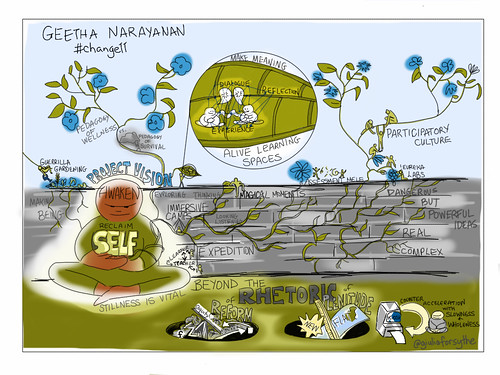Evidence that learning cannot be contained within the boundaries of a course, I’ve taken a couple double takes reading both Audrey Watters’ and Mike Caulfield’s excellent critiques about Sugra Mitra and his Hole in the Wall project in India.
Caulfield also tweeted a link to this excellent essay by Morozov touching on the topic of his book about solutionism,: which is “an intellectual pathology that recognizes problems as problems based on just one criterion: whether they are solvable with a nice and clean technological solution at our disposal”
This harkened me back to last year during #Change11 week 24 session hosted by Geetha Narayanan. I was totally blown away by her live session (of which I can’t seem to find the archive). I took many notes. Even on paper!
I still don’t feel my final version did her work justice, but it still works for me as an excellent memory anchor of her wonderful thinking about deep, meaningful learning which she describes as slow learning.

cc licensed ( BY NC SA ) flickr photo shared by giulia.forsythe
This short clip George Siemens recorded after Geetha’s keynote at the Global Summit 2006, summarizes her perspective very succinctly.
Paraphrased:
Slow learning can best be understood in counter position to fast knowledge.
Slow food movement, we enjoy the flavours of the food. We appreciate cultures, traditions, food making and world making that comes with it.
You must understand that food is a complex phenomenon. You can’t just eat it while doing something else
This is what is happening to learning.
Learning is happening very much on the run. Many of the discussions have been to destabilize the school structure. We are asked to do more and more and more in less and less time, such that students don’t understand flavour of their learning.
Slow learning is about the first person consciousness. It’s the primacy of experience, to make learning directly embedded in your first person consciousness.
We’re finding the major patterns and trends in teaching and learning are memetic; composed of fashions and fads, rather than search for true value inherent in learning.
There is a place for technology. In fact technology will be at the core of new learning and will contribute to a lot of change. But not as long be wary of policies and corporations eager for a marketed product.
You can’t put learning in an information kiosk.
The current mantra of the government of India, “have kiosk, will learn.”

Learning Kiosk
















